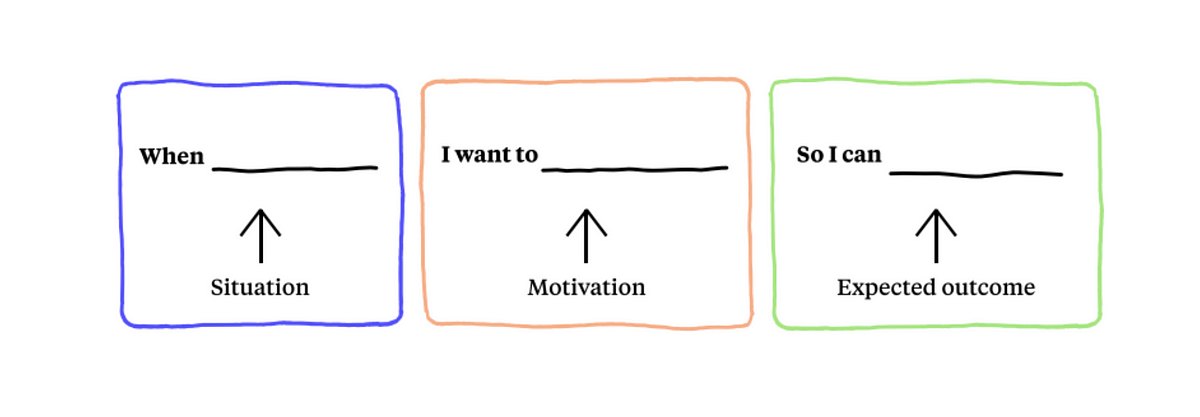How to Combine JTBD, Objections and STEPPS Frameworks to Market Startups

There is a data-backed hack that can help you find high-conversion messages for your startup faster and better. You can combine the Jobs to Be Done Framework (JTBD), the list of your customer objections and the STEPPS marketing framework to define the most effective messaging and ad copy for your brand. Let’s see how and dive into each framework first.

Using The Jobs To Be Done (JTBD) Framework for Your Brand Message
The JTBD framework is a cool tool that helps you to understand what your customers really want from your product or service. It goes beyond traditional demographic targeting, focusing instead on the underlying reasons why customers 'hire' a product or service. In the context of brand messaging, JTBD can be transformative. It follows this formula:

Here's how to leverage it in advertising:
- Identify the 'Jobs': Start by specifying the specific 'jobs' your customers are hiring your product to do. They can be functional (e.g., save time, increase efficiency), emotional (e.g., feel secure, gain prestige), or social (e.g., fit in with a group, stand out from the crowd). You can use the strategy section of Aiter.io to define these jobs. Here is how it looks for IndieHackers, for example:

- Understand the Context: Each job is performed in a specific environment and circumstances. Understand this context to craft messages that resonate powerfully. For example, a job done in a professional setting might require a different message tone than one in a personal or time-out context.
- Align with Consumer Goals: Your brand message should align with the end goals your consumers are trying to achieve. This alignment ensures that your message speaks directly to what your customers need most.
- Craft the Message: Use the insights from JTBD to craft ads that are not just about features or benefits, but about fulfilling the customer's job in the best way.
This way you can develop brand messages and ads that are not only convincing but also deeply rooted in the actual needs and desires of your customers. Now let’s see how to use objections to craft ads.
Navigating Customer Concerns: Objection-Focused Ads
Making ads that focus on common customer worries is a smart way to deal with issues that might stop someone from using your product or service, it changes negatives into positives. Here's a simple way to include customer objections in your ads:
- Identify and Address Objections: Gather the most common objections your customers have, such as price or complexity, through feedback and surveys. Develop ads that directly address these concerns with reassuring messages. For example, if price is an issue, emphasize value and cost-effectiveness. Here is an example of objections-targeted ads generated with Aiter.io for IndieHackers

2. Test and Optimize: Use A/B testing for these objection-focused ads to determine which messages resonate best. Continuously refine your ads based on performance metrics like click-through and conversion rates, ensuring they effectively counter objections and improve engagement.
This streamlined approach to incorporating customer objections into your ad strategy not only enhances ad effectiveness but also builds trust by showing that you understand and address customer concerns. You can use customer reviews, CRM data or Aiter to define the key objections.
The Power of STEPPS: Transforming Ads with the Science of Virality
The STEPPS framework, which stands for Social Currency, Triggers, Emotion, Public, Practical Value, and Stories, is an influential tool for crafting compelling ads. By incorporating these elements, your ads can become more engaging and shareable, significantly enhancing their impact.
- Combine Social Currency and Triggers: Make your ads appealing by adding elements that make people feel exclusive or in the know (Social Currency), and link your product to daily habits (Triggers). For example, an ad for a fitness app could highlight its unique community and connect to everyday routines.
- Emotion, Visibility, and Usefulness: Create ads that spark emotions to boost sharing. Make sure your product is seen being used (Public) and emphasize its practical benefits (Practical Value). This approach not only grabs attention but also encourages sharing due to its helpfulness.
- Incorporate Storytelling: Use simple stories in your ads to make them memorable and relatable. A story that shows someone benefiting from your product can be both inspiring and informative, making your ad more impactful.
STEPPS is another framework that allows you to add more dimensions to your ads and brand message. Now let’s see how to combine these three frameworks to succeed.
The Brand Message Algorithm. Putting the Advertising Ducks in a Row
Each of the frameworks mentioned allows you to create 5-10 variations of the ad with the same copy structure. For example, you can create ten ads that target different customer needs (JTBD) or objections. Then you can advertise them to the same audience to find the message that works the best. The algorithm looks like this:
- Generate ads that target different customer needs/objections/STEPPS.
- Launch these ads on the preferred ad platform. Make sure to target all of the ads to the same audience and spend the budget evenly. The more people you get to the website in total, the higher will be the statistical significance of your experiment. The rule of thumb is that each ad should get at least ~500 clicks.
- Compare the click-through and conversion rates for each ad. Pick one ad from each framework that has performed the best and delivered the most conversions.
- Now you know which customer need (JTBD) is the most appealing to your audience, what objection is the most crucial for them and which letter from STEPPS is “yours”. You can use these messages separately in campaigns or combine them to define your brand message and value proposition.
As a result, your startup will have a data-backed brand message that hooks your audience. Congrats!
 Why would you NOT buy my product?
Why would you NOT buy my product?

Cool, thank you.
I also like getting JTBDs from in-depth interviews. With ChatGPT it became easy – I can just feed the transcriptions to it and ask to extract some JTBD.
Yep, I like in-depth interviews. Another way to utilise them is to use people's language from the interviews to create ads. As a result, you talk to them in their language.
How do you do it in ad accounts? Like, create different ad groups or what?
Hey, so I create a different ad group for each message. The one that gets the highest CTR is the winner.
Dove into JTBD, objections, and STEPPS for my startup, and wow, what a difference! Engagement and retention are way up. It is great to get all packed together via one tool without talking for hours to ChatGPT.
Glad to meet like-minded people here)
Know this tool from their Twitter (oops, X) for a couple of months. Love their "creative" mode of content generation 😍
Cool, thank you for the feedback)
The outcome looks great, but what engine is running behind this Aiter service? Is it free to use?
Aiter uses OpenAI with some of its own algorithms.
You can try it for free, it also has paid plans.
This article does a good ass job of providing a comprehensive overview of how startups can leverage data-backed frameworks to refine their messaging and ad copy effectively. Integrating the Jobs to Be Done (JTBD) Framework, objection-focused ads, and the STEPPS marketing framework offers startups a strategic approach to crafting compelling messages that resonate with their target audience, which I completely agree with !!!
As a ghostwriter specializing in assisting B2B and B2C tech agency executives in refining their brand messaging and online presence, I've seen firsthand the impact of incorporating such frameworks into marketing strategies. By understanding customers' underlying needs, addressing objections, and incorporating elements of virality, startups can create impactful messages that drive engagement and conversions.
That step-by-step algorithm provided in the article offers a practical guide for executing these strategies effectively, allowing startups to really experiment with different variations and optimize their messaging for maximum impact. It's evident that a nuanced understanding of customer behavior and effective storytelling are key drivers of successful advertising campaigns in today's competitive landscape!
Thanks for the summary!
To effectively market startups, integrate Jobs-to-be-Done (JTBD) framework to understand customer needs, address objections using objection-handling techniques, and utilize the STEPPS framework (Social Currency, Triggers, Emotion, Public, Practical Value, Stories) for viral marketing. Identify how your product fulfills customers' jobs, preemptively handle objections in your marketing messaging, and create shareable content aligned with STEPPS principles. This combined approach aligns product-market fit, addresses customer concerns, and maximizes word-of-mouth potential for successful startup marketing.
Thanks for the summary, cheers!
Great tip, figuring out and aligning with the "jobs" of clients is crucial to marketing
Thanks for the feedback!
Thank you for sharing such great tips, it's very helpful.
Thank you for your feedback @benstock!
Thanks for sharing, super good read!
Thank you for your feedback @fekdaoui, that inspires me to write more)
Ten years ago, JTBD was totally different and give really important directions to corporates. At Unilever, a brand had max 4 JTBDs in a year. That are the most important objective of the brand. For example: "Axe JTBD, make 18-25 years old male persona use AXE deo more 4 times a day and increase consumption rate %5 in 2012." Then, all the projects and marketing communication built projects to serve this JTBD. It was good, like more OKR usage. Always think and building it with SMART methodology. ıf you have any question about this dusty subject, I am here.
Coolio, thank you for sharing this look back into history.
Teşekkürler!
cool
Thanks for feedback!
Jobs to be done theory, also called jobs theory, posits that people don't buy products; they “hire” them to do jobs, such as solving a problem or fulfilling a desire.
Yep, correct, thank you for the contribution
Sounds cool, thanks a lot!
Thank you for the feedback!
add to my collections
Thank you for the feedback!
Great to hear about your success! It's inspiring to see how implementing these frameworks can make such a difference. Keep up the good work!
Learned a lot from this framework! good job
Thanks a lot for your feedback @Baensaf, appreciate this.
This is very useful frameworks! thank you for sharing!
Thanks @andilaila!
Thanks,
I have learned a new way to overcome customers' objections in a new way.
I also use a User Persona (demographics + psychographics + how it relates to the end user).
It is more included within the Growth Strategy Template here I compile for SaaS companies interested in achieving their "North Star OKR" faster. Feel free to look through if you are curious.
I also appreciate the Jobs to be Done framework because it helps to better outline how each product feature aligns with the end user's UX/workflow.
What do you think about the Growth Strategy?
I've combined some of the following growth-oriented frameworks in there:
If anyone is interested in a free Growth Strategy (with a free Growth Roast), let me know here or in the comments below.
Well, this is a very nice framework, mate.
Thanks for sharing, I love this kind of detail.
How long did it take for you to compile a doc like this?
It depends on the structure of the business as a while, @dsemonov
If it is super simple: 1 Persona, 1 Four Fits, 1 Concept, triple-focused spreadsheet, and a dedicated Growth Playbook dedicated to 1 User Persona. (1-2 days, at most)
If it is complicated, it becomes 3-10 days.
I also saw that you are building Aiter. I am interested to learn more about Aiter.
That's cool, thanks.
Let's connect on LinkedIn? https://www.linkedin.com/in/dsemonov/
Re https://aiter.io/ – it's a marketing tool that allows you to generate ads and strategy ideas with a click. What questions do you have specifically?
I appreciate you sharing this smart strategy for effective branding!
Thank you for the feedback, @premsaini! :)
I had average success with the JTBD in the past but this new "AI way" looks promising. Need to give it a try...
Thanks for sharing your feedback :)
Really diving into different business related frameworks right now so this was incredibly helpful thank you.
Wow Amazing. https://trafficriderpro.in/traffic-rider-apk-for-ios/
Great tips
Thank you for the feedback @sailxjx